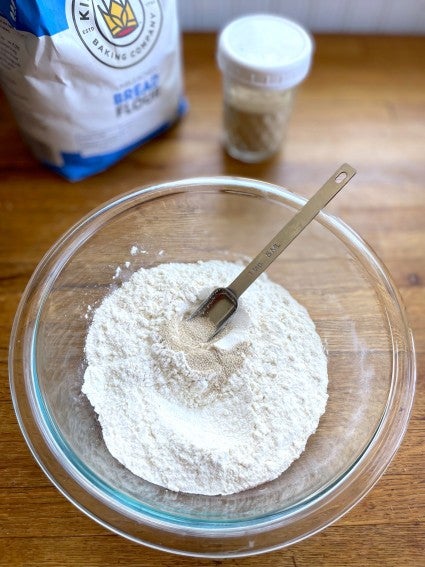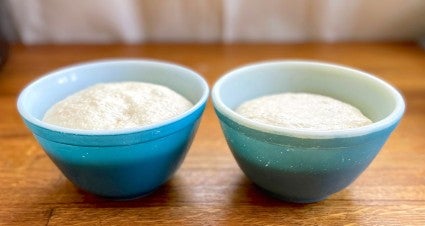Things bakers know: Instant yeast is superior to active dry. Here’s why.
Speed, price, ease of use — and results.


I haven’t used active dry yeast in my homemade bread, rolls, and pizza for nearly three decades. Not a single granule. And it’s not because I’m a sourdough purist.
So, what’s the deal? How do I get my dinner rolls to rise?
Instant yeast: the only type of yeast I’ve used in my kitchen since King Arthur introduced it to home bakers over 25 years ago. Specifically, I use SAF Red instant yeast (or SAF Gold for sweet breads). And in all that time (over 1,000 bakes later), I’ve never had a yeast-induced failure — not even the times when I used some 6-year-old SAF I discovered in the bottom of my chest freezer!
And it’s not just me who prefers instant yeast – it’s been a staple in both our King Arthur Test Kitchen and King Arthur Bakery for over 20 years.
Can you bake great bread with active dry, rapid, fresh compressed, or other kinds of yeast? Of course, and people did, for decades. But times change. Here’s why I always have instant yeast in my freezer — and why you should, too.

Mix instant yeast with your flour and other dough ingredients; there’s no need to dissolve it in warm water or another liquid first, as you might with active dry or other yeasts that need to be proofed (i.e., dissolved to ensure they’re alive). That’s one less step to take; 10 minutes proofing time saved.
Plus, instead of having to rip open the typical tiny pre-measured packet of active dry yeast — which might not even contain the amount you want to use — you simply have to spoon instant yeast from its 1-pound sack (or the container you’ve stashed it in).

Not only does it skip the proofing/dissolving step, instant yeast simply ramps up more quickly than active dry. Dough made with instant yeast and shaped into a loaf will rise to its optimal height significantly more quickly than a shaped loaf made with active dry yeast.
In fact, instant yeast is equivalent to rapid-acting yeast in initial speed, starting to raise dough almost immediately. But instant yeast will keep working long beyond the quick arc of rapid yeast, allowing you to refrigerate your instant-yeast dough for days and still get a good, strong rise at the end.
A pound of instant yeast is ridiculously inexpensive: you’ll only use about 11 cents of instant yeast (the equivalent of a standard 1/4-ounce packet) in each loaf you bake. Compare that to the $1.66 per one-loaf packet Amazon’s currently getting for active dry yeast; or even the 90¢ per packet charged at a typical supermarket. (Want to increase your savings even more? See How to bake bread using less yeast.)
Substitute instant yeast 1:1 by weight or volume for any active dry yeast called for in your recipe. If your recipe calls for a packet of yeast (7g, a slightly heaped 2 teaspoons), use the same amount of instant. Simply add it to your bowl along with the flour and other dry ingredients; no need to dissolve it first. See? Quick and easy.
You don’t know how you’ll ever use up a pound of yeast? Stored in an airtight container in the back or bottom of the freezer, it can last for years. But honestly, you’ll love baking with instant yeast so much it won’t be around nearly that long!

SAF instant yeast is used every day in the King Arthur Test Kitchen. It’s certainly my yeast of choice; and I hope from now on it’s yours, too. In case you’re curious, here are a few of my go-to (instant) yeast recipes:
Classic Sandwich Bread — This nostalgic pan loaf is close-grained, nicely sliceable, and perfect for sandwiches and toast.
Golden Pull-Apart Butter Buns — I’m absolutely required to make these soft white rolls for every family holiday dinner and gathering.
Grandma Pizza — Not super-thin, not ultra-thick, this crust is the perfect base for my favorite topping combo: sautéed portobello mushrooms, artichoke hearts, oven-roasted cherry tomatoes, and a mixture of mozzarella and provolone cheeses.
Soft Cinnamon Rolls – The tangzhong method (think Japanese milk bread) keeps these classic pull-apart-and-unravel rolls nice and soft for days.
Tuscan Coffeecake — Loaded with dried fruit and toasted walnuts, this rich, dense loaf features an inspired sugar-vanilla crackly glaze.
Want to know more? For a complete comparison of instant vs. active dry vs. rapid yeast, see Which yeast to use?
Cover photo and food styling by Kristin Teig.


